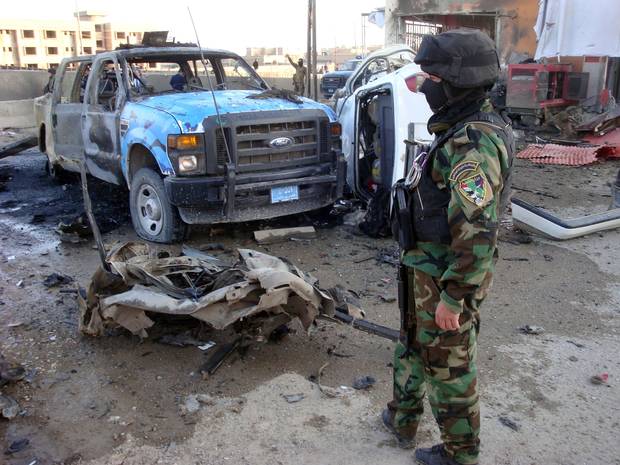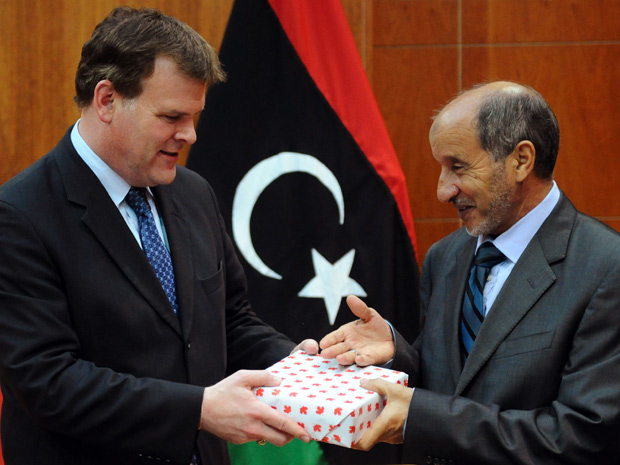Iran’s conventional military modernization has been largely overshadowed by discussions about its alleged nuclear weapons program. With the exception of long-range ballistic missiles presumed to be delivery systems for potential Iranian nuclear weapons, mainstream international media rarely discusses other aspects of Iran’s ongoing military modernization. This multi-part series for the NATO Council of Canada will cover Iran’s ballistic missiles, rockets and cruise missiles, air defences, naval forces, and unmanned aerial vehicles  (UAVs).
(UAVs).
Iran has made impressive progress in developing its military modernization capabilities in the past decade. In 2004, Iran’s military was a largely decrepit force incapable of dealing with the four most likely major threats scenarios (from Tehran’s perspective) the country faced: an American invasion, a naval conflict with the United States in the Persian Gulf, a conflict with any of the Arab Gulf states with or without American involvement, and Israeli and/or American airstrikes on Iran’s then relatively emerging nuclear program.
Iran’s response was tempered by technological shortcomings, limited materials and intellectual resources, and the inherent difficulty in challenging a superpower and its allies and clients. In light of the circumstances, Iran decided to build upon existing strengths and to bolster weaker aspects of its conventional military forces. It undertook what is generally referred to as an asymmetric approach – intentionally focusing on capabilities that take advantage of an adversary’s material, tactical, strategic, economic, psychological, moral, and political limitations and vulnerabilities. The fruits of these efforts took time to manifest themselvesm but are becoming increasingly clear today.
For coercive and deterrent purposes, Iran continued developing its then emerging conventionally-armed ballistic missile forces. Iran’s small but growing inventory of Shahab-1 (Scud) and Shahab-2 (~750 km range) short range ballistic missiles were supplemented by increasing number of Shahab-3 medium range ballistic missiles (~2,000km range in its most recent variant, the Ghadr). The newer systems, the Shahab-3 and Ghadr, allowed Iran to strike all its neighbouring countries, American bases in the region, and, for the first time, targets in Israel. Iran acquired some of these missiles via third parties that had obtained Soviet-built Scuds, and later purchased a production line from North Korea for a number of systems derived from the Soviet Scud.

While the Shahab-3 is Iran’s best known ballistic missile, it is no longer Iran’s most capable medium range ballistic missile and has been considered a second-tier weapon for a number of years. The Shahab-3’s effectiveness is hampered by its liquid fuelled propulsion system that necessitates a long fuelling process prior to launch. Iran designed the Ghadr, a modified and improved Shahab-3, to partially minimize the disadvantages inherent in the Shahab-3’s design. Notably, Ghadr marked the evolution of Iranian ballistic missiles beyond simple copies of a license-produced North Korean product.
To overcome the larger problem, Iran developed the Sejjil medium-range ballistic missile (~2,200 km range) in 2008. An original ‘Iranian’ design, the Sejjil is Iran’s first solid-fuelled medium-range ballistic missile – a system that enables Iran to rapidly launch missiles at any of its neighbours without undergoing lengthy fuelling prior to launch. Whilst some foreign experts and commentators have previously voiced scepticism about the Sejjil’s operational status given the low number of test launches, Iran appears to have inducted the missile into service in significant numbers based on the large number of transporter erector launchers (TELs – i.e., launch vehicles) displayed on recent military parades and delivery ceremonies.
While Iran has long been alleged to either have or be developing longer-range ballistic missiles that would bring much of India, Europe, Russia, and even the United States within range, it appears to have decided the current coverage provided by the Shahab-3, Ghadr, and Sejjil to be sufficient for its purposes. Instead of developing systems with greater range, Iran has been improving the aforementioned missiles by improving its mastery of propulsion, structural design and composition, and warhead design. The existence of the Ghadr, Sejjil, and Qiam are testimony to this view.
In addition, Iran has been developing shorter-range ballistic missiles for the purpose of targeting the Arab Gulf states and American bases in the Arab Gulf states. Iran last unveiled an entirely new ballistic missile in 2010 in the form of the Qiam 1 ballistic missile (~750 km range). While the Qiam appears to be based on the design of the Shahab-2, it is a new ballistic missile and no mere copy of any existing design. Qiam is significantly smaller than the Shahab-3 and Sejjil missiles but is described as being more capable of penetrating the numerous anti-ballistic missile defences fielded by the Arab Gulf states and the United States. Of main interest to observers are the Qiam’s warhead design and aerodynamic controls – developments that are indicative of a more sophisticated system. However, the Qiam’s range is not remotely sufficient to target any part of Israel, an indicator of the purposes of Iran’s conventionally-armed ballistic missile forces beyond any nuclear delivery role.
At a lower tier, Iran has been refining the Fateh-110 short-range (quasi) ballistic missile (200-300km range depending on the variant) first introduced in 2002. Based on a Chinese design that led to the Zelzal rocket, the Fateh-110 has been one of Iran’s most successful missile projects, spawning a number of generations and variants, including export models. Whilst incapable of striking targets deep inland on the Arab side of the Gulf, the Fateh-110 enables the targeting of many coastal cities, military facilities, desalination plants, ports and airports, and hydrocarbon-related facilities. The Fateh-110 is solid fuelled, a characteristic that enables rapid launch without fuelling, and is generally considered to be Iran’s most accurate ballistic missile.
The Fateh-110 has been modified to create at least three distinct variants beyond the four evolutionary generational variants. The first to be unveiled was the Khaleej Fars missile, an anti-ship ballistic missile that will be discussed in a forthcoming article in the series. The second and third were simultaneously unveiled in 2014. Of these, one is the Hormuz-1 missile, a Fateh-110 with an anti-radiation seeker that enables the ballistic missile to passively home in on emitting radar systems. If successful in this mission, no small feat, the Hormuz-1 would render useless the large numbers of anti-ballistic missiles operated by Iran’s adversaries by depriving them of vital radar targeting and detection inputs. The second, the Hormuz-2, is externally similar to the Hormuz-1 but was described as having a naval role and will also be discussed in a forthcoming article of the series.
Part II will focus on Iran’s battlefield rockets and cruise missiles.




